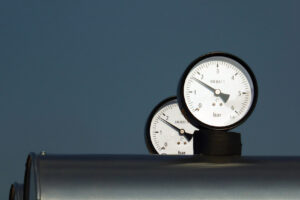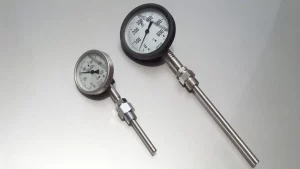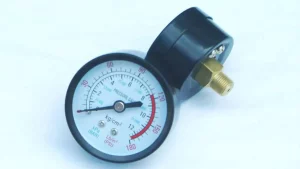Pressure-measuring device that was invented in 1849 by French engineer Eugene Bourdon. It is used to measure the pressure of fluids and gasses within pipes, vessels, and other closed containers. The Bourdon tube consists of a curved, U-shaped metal tube which is connected to the pressurized fluid or gas being measured.
Do you ever wonder how the pressure gauges in our cars, water pipes, and HVAC systems measure off vital readings?
A bourdon tube is an incredibly simple yet powerful contraption that has been used for decades to accurately measure different types of pressure. In this blog post we will explore exactly how this amazing invention works and its role in today’s industrial world.
Describe the structure of a Bourdon Tube
The Bourdon tube consists of a curved metal tube, typically made from copper, with an open end and a closed end. The open end is connected to the pressurized fluid or gas via a hose or pipe. As the pressure increases in the chamber or container being measured, the internal pressure of the Bourdon tube increases as well. This causes the curved portion of the tube to straighten out and push against a pointer mechanism connected to a dial. The movement of the pointer indicates the pressure reading on the dial.
Explain how a Bourdon Tube works
The way that a Bourdon tube works is quite simple; as pressure increases, it causes the curved portion of the tube to straighten out. This creates tension within the tube and pushes against a pointer mechanism connected to a dial.
As the pressure increases, the pointer moves across the scale indicating higher or lower pressures on the dial. The pointer will remain in its current position until the pressure either decreases or increases, allowing for accurate readings over time which can be monitored and recorded.
Describe the different types of Bourdon Tubes and their uses
There are several different types of Bourdon tubes which vary in their design and intended usage.
The most common type is the C-shaped tube, which is used to measure low pressures. This type of tube is typically connected directly to a pressurized container or vessel and measures the pressure within it. Other types include the spiral, helical, and diaphragm styles. These types of tubes are used to measure high-pressure gasses or liquids such as those found in boilers, furnaces, and hydraulic systems.
Advantages and Disadvantages of bourdon Tube
There are numbers of advantages of bourdon tube can be seen in different systems but some disadvantages are also with solutions
i. Accuracy & Precision
One of the most important benefits of Bourdon Tube is its accuracy, it can measure both static and dynamic pressure accurately.
ii. Low Cost and Easy Maintenance
It is an inexpensive device, and it is relatively easy to maintain and install. For decades this pressure gauge has been used by professionals to measure the pressure of liquids and gasses.
Disadvantages of the Bourdon Tube
i. Sensitive to Temperature Fluctuations
The accuracy of Bourdon tubes can be affected by temperature and vibration. In addition, this tube can easily be damaged due to its exposed construction which makes it vulnerable to corrosion or wear and tear.
ii. Hysteresis
Sometimes Bourdon tube pressure gauges respond slowly to changes in pressure which are subjected to hysteresis, but a quick solution is available to tackle these problems.
Tips on Selecting the Right Model for Your Application
When choosing the right Bourdon tube for your application, it is important to consider the type of fluid or gas being measured and its specific pressure range. You should also ensure that the model you select can withstand any temperature changes or vibrations that may occur in the environment where it will be used.
Furthermore, you should pay attention to both accuracy and precision when selecting a model. Finally, always make sure to read the manufacturer’s specifications carefully prior to making your purchase.
Discuss potential applications for a Bourdon Tube in everyday life
The Bourdon tube has been an essential component in measuring pressure since its invention in the mid-1800s. This device is simply designed but very effective for providing accurate readings of changes in pressure. Here are some applications in industrial and commerce settings;
Water Treatment
Bourdon Tube is very useful in water treatment in water plants to measure the water pressure to make sure that water is pumped and treated at optimal pressure.
HVAC systems
This tube plays an important role in the HVAC system, because it measures the air pressure in heating, air conditioning systems and ventilation.
Medical Use
Bourdon tube plays a key role in the medical field because it is used in many medical devices for gauging the pressure such as anesthesia machines and blood pressure monitors.
Pneumatics and Hydraulics
This tube is used in Hydraulic and Pneumatics systems for providing correct pressure of liquids and air in pipelines, cylinders and pumps.
FAQ’s
What is the Bourdon tube?
Bourdon tube is a device used to measure the pressure of liquids and gasses in various applications
What is the range of pressure which Bourdon tube can measure?
Bourdon tubes can measure pressure ranges from 0.6 to 7000 bar (8 to 10000) psi.
Conclusion
The Bourdon tube is an effective and reliable pressure-measuring device that has been used for more than 150 years in a wide variety of industrial applications. This simple yet powerful invention works by using tension created by increasing pressure on a curved metal tube to push against a pointer mechanism connected to a dial. While it has several advantages over other pressure-measuring devices, the Bourdon tube can be damaged due to its exposed construction and can be affected by temperature and vibration.



